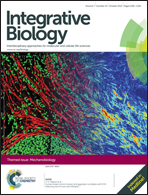Modeling the finger instability in an expanding cell monolayer†
Abstract
Collective motion occurs in many biological processes, such as wound healing, tumor invasion and embryogenesis. Experiments of cell monolayer migration have revealed the spontaneous formation of finger-like instabilities, with leader cells at their tips. We present a particle-based model for collective cell migration, based on several elements that have been found experimentally to influence cellular movement. Inside the bulk we include velocity alignment interactions between neighboring cells. At the border contour of the layer we introduce the following additional forces: surface-elasticity restoring force, curvature-dependent positive feedback, and contractile acto-myosin cables. We find that the curvature-driven instability at the layer edge is necessary and sufficient for the formation of cellular fingers, which are in good agreement with experimental observations.

- This article is part of the themed collection: Mechanobiology

 Please wait while we load your content...
Please wait while we load your content...